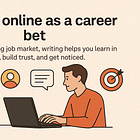27. How to get lucky in your career
Practical tips to increase your chances of career breakthroughs by maximising your 'luck surface area'
We often celebrate hard work, talent, and perseverance as the cornerstones of success. And they are. But for truly extreme success, there's almost always a hidden variable at play. That unseen hand, that perfect timing, that unexpected connection – we call it luck.
No matter how much you plan, how hard you work, or how smart you are, there's always an element of chance that contributes to breakthrough achievements. You can't control luck, but you can influence how often it finds you.
Think of it like this: if you're searching for a job, your chances of getting "lucky" with an unexpected lead or a perfect connection are far higher at a startup event than they are sitting at home watching Netflix. You're increasing your "luck surface area."
In this post, we will go through a few things you can try to improve your luck surface area.
Prepare the Soil by Becoming Radically T-Shaped
For years, we’ve been fed a false dichotomy: should you be a generalist or a specialist? The debate is a trap. It encourages you to choose between being a jack-of-all-trades with no real depth, or a niche expert with crippling blind spots.
The most effective and "lucky" people I know have rejected this choice. They aren't an "I" (a specialist) or a "—" (a generalist). They are a "T".
The T-shaped individual has two key components:
1. The Horizontal Bar: A broad base of knowledge across many disciplines. They can talk to marketers, understand the basics of finance, and grasp the core concepts of different programming languages.
2. The Vertical Bar: A deep, spiky area of true expertise. This is the one thing they are exceptionally good at, the skill they have honed through deliberate practice and real-world experience.
This model isn't new, but the arrival of AI has supercharged its importance and changed the rules of the game.
AI Owns the Horizontal Bar
Acquiring general knowledge used to take years of reading and study. Today, AI makes it nearly instantaneous. With a few prompts, you can get a working summary of quantum computing, a boilerplate Python script for web scraping, or the key principles of behavioural economics.
This means that being just a generalist is no longer a defensible career strategy. The barrier to entry for broad knowledge has collapsed.
Expertise is Your New Moat
What AI cannot do is replicate true, earned expertise. It can't replicate the intuition you gain from shipping a product and watching it fail, the nuance you learn from debugging a system under pressure for hours, or the wisdom that comes from making a thousand tiny decisions within your domain.
This is the vertical bar of your "T," and it is more valuable than ever.
Your goal, then, is not to choose between being a generalist or a specialist. It is to use AI to aggressively expand your horizontal bar while you relentlessly deepen your vertical one. Your deep expertise gives you the context to ask AI the right questions, and AI gives you the leverage to apply your expertise in ways you never could before.
Actionable Steps:
Define Your Vertical Bar: What is the vertical bar of your T? If you're not sure, find the intersection of three things:
1) What are you genuinely excited about?
2) What do you have a natural talent for?
3) What does the market value?
This is where you should be investing your time in deliberate, focused practice.
Appoint AI as Your "Generalist Intern": For everything outside your vertical bar, treat AI as an infinitely knowledgeable intern. Need to understand a new marketing trend for a meeting? Ask your AI. Need to write a SQL query to pull some basic data? Ask your AI. This frees up your cognitive bandwidth to focus on deepening your core expertise. But also know how to use AI well to get the best out of it.
Here are some tips for that:
Plant the Seeds
An expert with deep, T-shaped skills who stays silent is invisible. Opportunities can't find you if they don't know you exist. The antidote to invisibility is simple, not easy: you must make your thoughts and your work visible.
The gold standard for this is "Building in Public." We see indie hackers and open-source developers sharing their revenue dashboards, their code, and their user feedback. It's incredibly effective, but it's also intimidating. Many of us think, "I don't have a product to build," or "I don't have the time for a side project," or simply, "I'm not an expert yet."
This is where a more powerful and accessible strategy comes in: "Learning in Public."
If you don't have something to build in public, you can learn in public. The principle is the same: you are creating a public trail of your curiosity, your process, and your growth. This simple shift from "expert" to "curious learner" lowers the stakes and removes the pressure of perfection.
I wrote about it here in detail:
More importantly, it dramatically increases your luck surface area. By sharing what you're learning, you attract a specific set of people:
Fellow learners on the same path who become your peers.
Experts who see your curiosity and want to help you go further.
Hiring Managers and Leaders who value initiative and a growth mindset far more than quiet, stagnant expertise.
The best part is that you can start this in the safest environment you have: your current workplace.
You don't need to launch a blog or a newsletter tomorrow. You can start by sharing your learnings asynchronously. The next time you go down a rabbit hole to solve a problem, post a quick summary in your team's Slack channel:
"Hey team, I was figuring out why our build times were so slow. Discovered it was an issue with X. Here's the 2-minute article that explained it all, in case anyone else runs into it."
Or you can be more structured. Offer to host a 30-minute "lunch and learn" session on a new technology you've been exploring.
Not everyone will engage. Most will scroll past. But some will. And that's enough. The people who do, the ones who ask questions, add their insights, or thank you for sharing, are the most engaged and curious people in your organisation. They are the collaborators, mentors, and sponsors you want on your side. You are making yourself known to the people who matter.
Water the Garden
The word "networking" makes most of us cringe. It brings images of crowded rooms, forced small talk, and transactional exchanges. If you're a selective introvert like me, this is actively draining.
The good news is that this model of networking is ineffective. The goal is to make connections. For introverts, this is a superpower. We don't thrive on shallow, wide-ranging interactions. We thrive on deep, meaningful connections built around shared interests and values.
So, how do you find these people without exhausting yourself?
Your efforts to "learn in public" act as a powerful filter. The content you share is a beacon. It doesn't attract everyone. It attracts your tribe. The ones who are interested in the same things, who appreciate your way of thinking, and who are on a similar journey.
This turns networking on its head. Instead of a draining outbound activity, it becomes a manageable inbound one. You're not hunting for needles in a haystack. You're tending to the high-quality leads that your public learning has already generated.
Actionable Steps:
Tend to Your Inbound: When someone responds to your post, asks a follow-up question, or shares your work, they are raising their hand. This is your signal. Your only job is to have a genuine conversation with them. Send a DM. Ask them what they're working on. You'll find that vibing with these self-selected people is often effortless.
Master Low-Lift "Give": The easiest way to build a connection is to be helpful. When you're talking to one of these like-minded people, look for an opportunity to help them in a small, low-energy way.
"I just read a great article on that, here's the link."
"I know someone who is an expert in that area. I'd be happy to introduce you.”
"That's a cool project. If you ever want a second pair of eyes on it for 15 minutes, let me know."
Schedule One "Comfort Zone" Coffee a Month: While inbound is powerful, there is still immense value in occasionally pushing your boundaries. But do it on your terms. Once a month, intentionally reach out to one person you find interesting but don't know. It could be the author of a blog post you admired or someone in a different department at your company. Send them a specific, appreciative message and ask for 20 minutes of their time. Also, ask specific questions - or even ask for help on a problem you are having - to get better responses.
Creating Your Catalysts
You've done the hard work. You've built your skills, shared your knowledge, and connected with good people. You've set the stage for luck to find you. But sometimes, even with the best setup, you still need a little push.
This final step is about actively creating small sparks that can ignite bigger opportunities. Think of them as "catalysts". Tiny actions that can lead to big reactions. You're not waiting for luck to strike; you're giving it a clear target.
Here's how to do it:
Build a tiny thing: Don't wait for a big project. If you learn a new skill, use it to build something small and useful, even if it's just for yourself. A simple script, a quick tool, a small website. It doesn't have to be perfect. The act of building it and then sharing it (even just with a few people) shows initiative and capability. It gives people something concrete to react to.
Ask a Smart Question: In a meeting, an online forum, or a public discussion, don't just listen. If you have a genuine, thoughtful question that shows you've been paying attention and thinking deeply, ask it. A well-placed question can make you stand out and start a valuable conversation with someone important.
Offer a Small Help: See someone struggling with a problem you know how to solve? Offer a quick tip, a useful link, or a five-minute explanation. Don't expect anything in return. These small acts of generosity are memorable. They build goodwill and can lead to unexpected opportunities down the line.
The point is to stop waiting for the perfect moment or the big break. Instead, create many small moments. Most of these little sparks might fizzle out, and that's okay. But every now and then, one will catch fire and lead to something you never expected.
Found this useful? A quick share helps me continue bringing you new insights each week. Thank you!




Super super helpful.
Very informative, yet actionable! A great read 👏